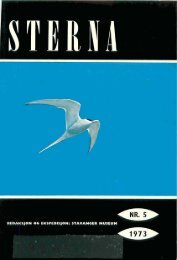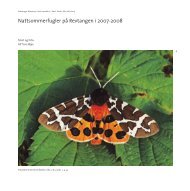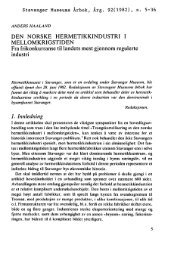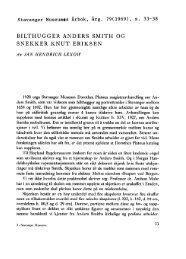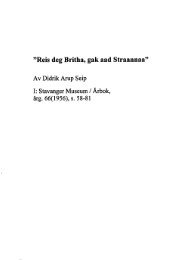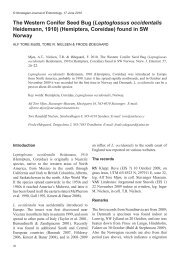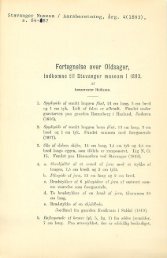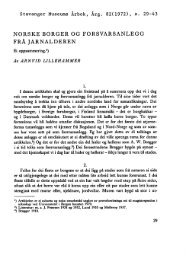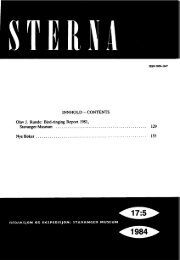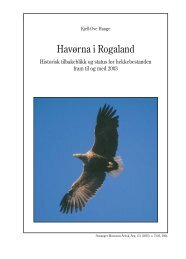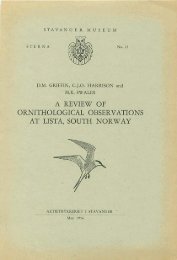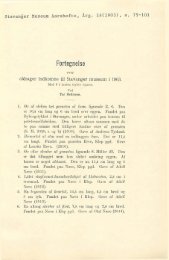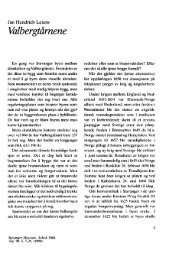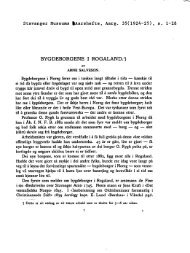Sterna, bind 13 nr 1 (PDF-fil) - Museum Stavanger
Sterna, bind 13 nr 1 (PDF-fil) - Museum Stavanger
Sterna, bind 13 nr 1 (PDF-fil) - Museum Stavanger
Create successful ePaper yourself
Turn your PDF publications into a flip-book with our unique Google optimized e-Paper software.
LITTERATUR<br />
Anfinnsen, hl. T. 1962. Fugleobscrvasjoncr fra Jaren somrene 1960 og 1961.<br />
Fauna 15: 92-100, Oslo.<br />
Barth, E. K. 1963. Flere ornitologiske observasjoner. Fautia 16: 109-125, Oslo.<br />
Bernhoft-Osa, A. 1956. Fuglenotiser fra BjBen i Setesdal og Norefjell i Buskerud.<br />
Stav. Mirs. Arb. 1956: 159-164.<br />
Fabricius, O. & Hald-Mortensen, P. 1969. Hjeilen (Plurialis apricaria) som ynglefugl<br />
i Danmark 1963-1966, med bemsrkninger om artens raceforhold, udbrcdelse og<br />
antal. Datask Orri. Foren. Tidsslir. 63: <strong>13</strong>7-160.<br />
Haftorn, S. 1971. Norges jugler. Oslo. 862 s.<br />
Lgvcnskiold, H. L. 1947: Hdndbok over Norges Fugler. Oslo. 887 s.<br />
Olsen, K. & Holgcrsen, H. 1970. Heilo p(i Lista sommeren 1970. Slerria 9: 219.<br />
Steiniger, F. 1959. Die grosset1 Regetipfeifer. Die neue Brehm-Buchcrei, hft. 240.<br />
Wittenbcrg/Luthentadt. 90 s.<br />
SULIMARY: THE GOLDEN PLOVER, PLUVIALIS APRICARIA, AS A<br />
BREEDING BIRD IN CO. ROGALAND. SW-NORWAY<br />
According to Norwegian Iiandbooks the Golden Plover bred fairly numerously in<br />
the costal arcas of South Norway at the end of the Inst century. The most important<br />
brecding grounds were on Jaren, Co. Rogaland, ancl Lista, Co. Vest-Agder. At the<br />
turn of the century thesc populations declincd severely, and the spccics finally disappeared<br />
from Lita and the lo\ver parts of Jaren (LEig-Jæren). In the inner parts of<br />
Jæren (Hos-Jaren) the specics continued to breed, but the population size and<br />
distribution \vcre unknown.<br />
In the years of 1968-72 this population \\'as censused by memben of NOF-Rogaland.<br />
The census \vas based on counting birds apparently holding territories. In thc<br />
first yean, before the distribution had been determined, different parts of the population<br />
were counted cach year. Only in 1972 did we succeed in censusing almost the<br />
total population, the result bcing 2<strong>13</strong> pain. As seen from Table I, the figures may<br />
vary from ycar to ycar. This may be diie to the censusing technique or to population<br />
fluctuations or both. but 1 do not think that the population to any extent excceds<br />
250 pain. Most of the counts were made in Junc. At the time, whcn most of the<br />
chicks are hatchcd (but still not fledged), the parent birds show vcry conspicuous<br />
bchaviour and are easily observed.<br />
Rrccding on islands in Rogaland has not been reported since the end of the last<br />
century. In 1971 Golden Plovers wcre found to be breeding on K<strong>nr</strong>mØy Island.<br />
Censuscs \vere carricd out in 1972 and 1973, but the potential breeding arcas were<br />
insufficiently covercd. In 1972 only 5 pain wcre found and in 1973 7 pain (Fig. 3).<br />
The spccies is probably morc numerous, cspecially on the southern part of the island.<br />
In the northwestern part of the county two possiblc breeding locnlities have been<br />
discovcred on the mainland. At Grindenes, Tysvar. Golden Ploven have stayed<br />
throughout the breeding season on suitable habitat for at least 14 years. Howcvcr, in<br />
1972 the spccies did not appear. In 1972 2-3 pain stayed at a suitable locality at<br />
Saltveit, Haugesund.




